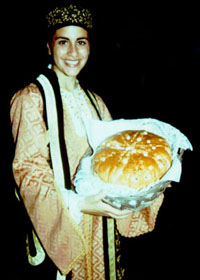 Contents -
Previous Article -
Next Article
Contents -
Previous Article -
Next Article
Round loaves have been popular amongst almost all Mediterranean people since ancient times. The basic shape came from the round ceramic bowls in which the bread was allowed to ride and in which they were baked.
The Romans were particularly fond of baking bread with the high gluten wheat that made the bread hold together during baking and so chewy and durable for carrying on a long journey. Although barley contains more protein than wheat, the Romans considered it the food of slaves and often, soldiers were given barley bread as punishment rations.
North Africa (Egypt and Modern Libya and Algeria) and Aquitania in Gaul (Modern Southern France) produced most of the cereal grains that supplied the Empire. The grain producing regions in the Roman Empire, like in all nations and empires before and since, had an enormous strategic military value. As the Roman people were to find out to their chagrin on mire than one occasion, He who controlled Gaul or Africa, therefore, had a stranglehold on the Empire. North Africa was so important in this regard that powerful generals often chose this province in which to rebel and set up their own empire in opposition to the legitimate Roman government.
Go to next article:
Go back to previous article: